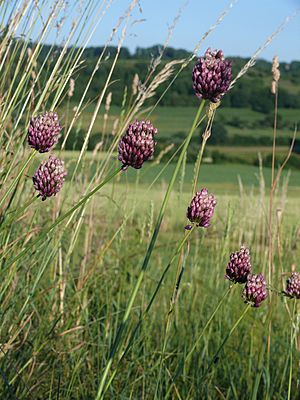Allium rotundum facts for kids
Quick facts for kids Allium rotundum |
|
|---|---|
 |
|
| Allium rotundum | |
| Scientific classification |
Allium rotundum, also known as the round-headed leek or purple-flowered garlic, is a type of wild onion. It grows naturally across a large area, from Spain and Morocco in the west, all the way to Iran and European Russia in the east. You can also find it growing in some parts of the United States, like Michigan and Iowa, where it has spread and started to grow on its own. This plant often likes to grow in places where the ground has been disturbed, such as along roadsides or in farm fields.
What is the Round-Headed Leek?
The round-headed leek is a fascinating plant that belongs to the Allium family. This family includes many plants you might know, like onions, garlic, and chives. Allium rotundum gets its common names from its round flower clusters and its purple flowers, which can look a bit like garlic. It was first officially described in 1762.
Where Does It Grow?
This wild onion is native to a huge region that covers parts of Europe, Asia, and North Africa.
- Europe: You can find it in countries like Spain, Italy, and parts of Russia.
- Asia: It grows in places like Iran and other temperate Asian regions.
- North Africa: Countries such as Morocco are also part of its natural home.
Sometimes, plants spread to new areas where they didn't originally grow. When a plant starts growing successfully in a new place without human help, it's called "naturalized." Allium rotundum has become naturalized in a few places in the United States, including the states of Michigan and Iowa. It often pops up in areas that have been changed by people, like the edges of roads or in fields where crops are grown.
What Does It Look Like?
Allium rotundum has some unique features that help you identify it:
- Bulbs: This plant grows in large groups, with as many as 50 bulbs clustered together. Each bulb is shaped like an egg and can be up to 1.5 centimeters (about half an inch) long.
- Leaves: Its leaves can grow quite long, reaching up to 40 centimeters (about 16 inches).
- Stems: The main stem that holds the flowers, called a scape, can grow very tall, sometimes up to 90 centimeters (about 3 feet) high!
- Flowers: The flowers grow in a special cluster called an umbel. When you look at it from a distance, this cluster looks very round, which is how the plant got its name. Each umbel can have as many as 200 individual flowers!
- Flower Details: The flowers themselves are shaped like tiny bells and are about 7 millimeters (less than half an inch) wide. Their petals, called tepals, are usually purple, but sometimes they have white edges. Inside the flowers, you'll see yellow or purple anthers, which produce yellow or white pollen.
See also
 In Spanish: Ajo pardo para niños
In Spanish: Ajo pardo para niños

